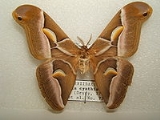
Samia cynthia
Encyclopedia
The Ailanthus silkmoth (Samia cynthia) is a saturniid
moth, used to produce silk fabric but not as domesticated as the silkworm, Bombyx mori
. The moth has very large wings of 113-125 mm, with a quarter-moon shaped spot on both the upper and lower wings, whitish and yellow stripes and brown background. There are "eyespots" on the outer fore wings.
, and is often referred to by the common name Eri silkmoth.
The eri silk worm is the only completely domesticated silkworm other than Bombyx mori. The silk is extremely durable, but cannot be easily reeled off the cocoon and is thus spun like cotton or wool.
Indigenous populations
Asia: China (Zhejiang, Shanghai, Jiangxi, Jiangsu, Shandong, Beijing, Shanxi, Liaoning, Heilongjiang); Korea (North Pyongan, South Pyongan, Pyongyang, Kangwon, South Kyongsan)
Introduced Populations (escaped from cultivation or introduced and naturalized)
Asia: Japan; India
Australasia: Australia
America: Canada; United States; Venezuela; Uruguay; Brazil
Africa: Tunisia
Europe: France; Austria; Switzerland; Germany; Spain; Bulgaria.
Saturniidae
The Saturniidae, commonly known as saturniids, are among the largest and most spectacular of the moths. They form a family of Lepidoptera, with an estimated 1,300 to 1,500 described species worldwide...
moth, used to produce silk fabric but not as domesticated as the silkworm, Bombyx mori
Bombyx mori
The silkworm is the larva or caterpillar of the domesticated silkmoth, Bombyx mori . It is an economically important insect, being a primary producer of silk...
. The moth has very large wings of 113-125 mm, with a quarter-moon shaped spot on both the upper and lower wings, whitish and yellow stripes and brown background. There are "eyespots" on the outer fore wings.
Eri silk
The common name 'Ailanthus silkmoth' refers to the host plant. There is a subspecies, S. cynthia ricini in India that feeds upon the leaves of castor bean, and is known for the production of eri silkEri silk
Eri Silk comes from the worm Samia cynthia ricini, found in North East of India and some parts of China and Japan. The name Eri is derived from the Assamese word ‘era’, which means castor as the silkworm feeds on castor plants. One of the common names, the 'Ailanthus Silk moth', refers to the host...
, and is often referred to by the common name Eri silkmoth.
The eri silk worm is the only completely domesticated silkworm other than Bombyx mori. The silk is extremely durable, but cannot be easily reeled off the cocoon and is thus spun like cotton or wool.
Range
Peigler & Naumann (2003) , in their revision of the genus Samia, listed material of true Samia cynthia examined as follows:Indigenous populations
Asia: China (Zhejiang, Shanghai, Jiangxi, Jiangsu, Shandong, Beijing, Shanxi, Liaoning, Heilongjiang); Korea (North Pyongan, South Pyongan, Pyongyang, Kangwon, South Kyongsan)
Introduced Populations (escaped from cultivation or introduced and naturalized)
Asia: Japan; India
Australasia: Australia
America: Canada; United States; Venezuela; Uruguay; Brazil
Africa: Tunisia
Europe: France; Austria; Switzerland; Germany; Spain; Bulgaria.

